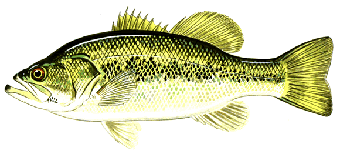Back to Previous Page
LARGEMOUTH BASS

At-a-Glance
- Scientific Name: Micropterus salmoides
- Found in Illinois: Statewide
- State Average: 10"
- State Record: 13 lbs/1 oz (1976)
- Best Lures: plastic worms, jigs, spinnerbaits, crank baits, minnows, crayfish, night crawlers, worms.
Because bass inhabit such a variety of habitat and can be fished throughout the day (and night), there are a wide variety of lures designed to do a certain function. The angler who knows the characteristics of each lure will certainly have the most consistent success:
- For surface fishing, top-water lures are designed to resemble distressed fish, frogs, and insects that are at the surface. These lures float and often have rattles or propellers to mimic a swimming movement in the water. Often bass will explode to the surface to "capture" the lure. It is important to wait a few seconds before setting the hook so the lure is not prematurely pulled out of the fish's mouth.
- For shallow-water fishing, lures that imitate minnows and float when resting and then dive only a foot or two on retrieve work very well. Spinnerbaits are also a popular choice.
- For medium-depth angling (4 to 12 feet), a medium- to deep-diving crankbait can be used. The diving depth of the lure is determined by the size and shape of the lip protruding on the front of the lure. Jugs and twister-tails are very popular and an effective lure. It takes some practice on the best techniques to attract bass by dragging, hopping, twitching, and pausing the jig, although many anglers feel a strike most often occurs when the jig is falling.
- For deep-water fishing, a plastic worm is a time-tested lure. Bass seek the comfort of cooler, deep water in late spring, summer, and early fall, and plastic worms are probably more effective than all other lures combined, at these times. Whether you prefer a Texas, Carolina, split-shot, or wacky rig, mastering the timing on your twitches and how to hop the worm along the bottom will be the key to successful worm fishing.
Habitat:
The largemouth bass is the most widely distributed of the black basses and occurs throughout Illinois. The largemouth prefers shallow, weedy lakes and river backwaters — the same type of habitat that produces bluegills. Bass are also well adapted for life in small lakes or ponds. Largemouth are drawn to structures and will frequently be found under lily pads or lying in the shade of overhanging trees, piers or brush during the daytime. They will often move into shallow water in the evening and stay until after dawn for feeding, then retreat to deeper water or shade for the day. They are seldom found at depths greater than the deepest water in which rooted vegetation grows. Largemouth bass can tolerate quite high temperatures, although they will seek out deeper, cooler waters in the summer if possible.
Feeding and Habits:
Largemouth bass are top predators in many lakes and are opportunistic feeders. They swallow their prey whole and will eat a wide variety of food. Largemouth bass mainly feed by sight, but they also use their lateral line, a sensory organ that runs along their body that can feel vibrations of swimming or distressed prey in the water. They typically search the weed beds and shallows for invertebrate and vertebrate foods, while keeping a vigilant eye on the surface for frogs, emerging mayfly or an unsuspecting dragonfly. Feeding drops off in late fall, and during the winter, bass are relatively inactive. The desire for warm water is shown by their spring migrations, seeking out the shallower littoral zones.
Reproduction:
Largemouth bass in Illinois typically reach sexual maturity between ages 2–4 years, depending where they are in the state. When spring water temperatures start to reach 60ºF, males will begin to move inshore and select a nest site. Males build nests on a variety of substrate types and are most often in depths of 2–3 feet of water. Each nest is a small depression, roughly 2 feet in diameter, formed by the male using his caudal fin to clear the area of debris.
Male courtship begins by attracting a female and herding her over the nest to spawn. The female will tip her body to deposit a few egg while the male releases a small amount of sperm, fertilizing the eggs. A spawning pair can stay active for several hours, with females releasing 2,000 to 7,000 eggs per pound of body weight. The eggs fall into the nest and are sticky so they attach to the substrate in the nest. Once spawning has ended, the female leaves the area; the male is left to provide all of the parental care, which includes fanning the developing eggs to provide oxygen and enthusiastically defending the area to keep predators away. Eggs usually hatch in 2–4 days and the larvae remain in the nest for about 5-10 more days (depending on temperature). When the fry become free swimming, they school above the nest with the male continuing his vigilant care.



